Brunanburh: Difference between revisions
mNo edit summary |
No edit summary |
||
| Line 1: | Line 1: | ||
'''The Battle of Brunanburh''' was fought in 937, one of the greatest and most | '''The Battle of Brunanburh''' was fought in 937, one of the greatest and most important battles of the Anglo-Saxon period, and one of the most bloody. It is attested in sources from all over the [[British Isles]] and in a Norse Saga, but the location of the battlefield is unknown. | ||
At Brunanburh, Athelstan (Æþelstan) King of the English defeated an alliance of Olaf III Guþfriþsson King of [[Dublin]] (Anlaf in English), Constantine II (or Conn) King of the [[Scotland|Scots]] and Eugenius I (Owen, or Eogan) King of [[Strathclyde]]. By this victory Athelstan cemented his rule in [[Northumbria]] and reaffirmed his overlordship in Britain. | At Brunanburh, Athelstan (Æþelstan) King of the English defeated an alliance of Olaf III Guþfriþsson King of [[Dublin]] (Anlaf in English), Constantine II (or Conn) King of the [[Scotland|Scots]] and Eugenius I (Owen, or Eogan) King of [[Strathclyde]]. By this victory Athelstan cemented his rule in [[Northumbria]] and reaffirmed his overlordship in Britain. | ||
| Line 66: | Line 66: | ||
Alistair Campbell concluded that: | Alistair Campbell concluded that: | ||
{{ | {{quote|The saga remains, accordingly, unsupported in practically all its details .. . If we abandon it, and abandon it we must, all hope of localising Brunanburh is lost. Unless new evidence can be produced, an honest nescio is greatly to be preferred to ambitious localisations built upon sand.}} | ||
Many locations across [[Great Britain]] have been suggested, mainly between the [[River Dee]] and [[Dumfriesshire]]: | Many locations across [[Great Britain]] have been suggested, mainly between the [[River Dee]] and [[Dumfriesshire]]: | ||
| Line 115: | Line 115: | ||
Wilkinson's work was subsequently referenced and expanded by a number of local authors.<ref>{{Citation|last=Partington|first=S W|year=1909|title=The Danes in Lancashire and Yorkshire|pages=28–43|url=http://archive.org/stream/danesinlancashir00partrich|accessdate=2012-05-15}}</ref><ref>{{Citation|last=Newbigging|first=Thomas|year=1893|title=History of the Forest of Rossendale|pages=9–21|url=http://www.archive.org/details/historyofforesto00newb|accessdate=2012-05-15}}</ref> New information was added including that around this time, the land between the rivers Ribble and Mersey had been re-conquered from Danish Northumbria and held by the crown until the Norman conquest. And although most of the sites mentioned have since been classified as much older, the story still interests some today.<ref>{{cite news|title=Was epic Anglo-Saxon battle fought in Burnley?|url=http://www.burnleyexpress.net/community/peek-into-the-past/was_epic_anglo_saxon_battle_fought_in_burnley_1_3661559|newspaper=Burnley Express|date=9 August 2011|accessdate=2012-05-15}}</ref> | Wilkinson's work was subsequently referenced and expanded by a number of local authors.<ref>{{Citation|last=Partington|first=S W|year=1909|title=The Danes in Lancashire and Yorkshire|pages=28–43|url=http://archive.org/stream/danesinlancashir00partrich|accessdate=2012-05-15}}</ref><ref>{{Citation|last=Newbigging|first=Thomas|year=1893|title=History of the Forest of Rossendale|pages=9–21|url=http://www.archive.org/details/historyofforesto00newb|accessdate=2012-05-15}}</ref> New information was added including that around this time, the land between the rivers Ribble and Mersey had been re-conquered from Danish Northumbria and held by the crown until the Norman conquest. And although most of the sites mentioned have since been classified as much older, the story still interests some today.<ref>{{cite news|title=Was epic Anglo-Saxon battle fought in Burnley?|url=http://www.burnleyexpress.net/community/peek-into-the-past/was_epic_anglo_saxon_battle_fought_in_burnley_1_3661559|newspaper=Burnley Express|date=9 August 2011|accessdate=2012-05-15}}</ref> | ||
In addition, Brunanburh is also named 'Wendune' by Symeon of Durham, the Wen- element remaining in the village of [[Winwall]], next to the conjectural battlefield (near [[Colne]]), and the name 'Vinheath' given by Egil’s Saga. Both ‘heath’ & ‘dune’ relate to the wide, raised land that the field lies on, as the word ''dun'' is 'consistently used for a low hill with a fairly extensive summit which provided a good settlement-site in open country' (Margaret Gelling). One final named for the battle, on 'The Plains of Othlynn' (in the Annals of Clonmacnoise) conjecturally connects to the [[Domesday Book]]’s ''Othlei'', for [[Otley]], whose lands stretched at least as far as [[Ilkley]], a few short miles from the field. Others have suggested that ''Othlynn'' (the Annals exist only in a hurried early modern English translation) is an error or rough transcription for ''Lochlainn'', meaning "Norway" or in context "Lands held by the Norse". | In addition, Brunanburh is also named 'Wendune' by Symeon of Durham, the Wen- element remaining in the village of [[Winwall]], next to the conjectural battlefield (near [[Colne, Lancashire|Colne]]), and the name 'Vinheath' given by Egil’s Saga. Both ‘heath’ & ‘dune’ relate to the wide, raised land that the field lies on, as the word ''dun'' is 'consistently used for a low hill with a fairly extensive summit which provided a good settlement-site in open country' (Margaret Gelling). One final named for the battle, on 'The Plains of Othlynn' (in the Annals of Clonmacnoise) conjecturally connects to the [[Domesday Book]]’s ''Othlei'', for [[Otley]], whose lands stretched at least as far as [[Ilkley]], a few short miles from the field. Others have suggested that ''Othlynn'' (the Annals exist only in a hurried early modern English translation) is an error or rough transcription for ''Lochlainn'', meaning "Norway" or in context "Lands held by the Norse". | ||
===Lancashire - others=== | ===Lancashire - others=== | ||
Latest revision as of 09:47, 27 June 2016
The Battle of Brunanburh was fought in 937, one of the greatest and most important battles of the Anglo-Saxon period, and one of the most bloody. It is attested in sources from all over the British Isles and in a Norse Saga, but the location of the battlefield is unknown.
At Brunanburh, Athelstan (Æþelstan) King of the English defeated an alliance of Olaf III Guþfriþsson King of Dublin (Anlaf in English), Constantine II (or Conn) King of the Scots and Eugenius I (Owen, or Eogan) King of Strathclyde. By this victory Athelstan cemented his rule in Northumbria and reaffirmed his overlordship in Britain.
This was one of the most decisive victories of the period, but it was fought at a time when chronicles were poorly kept and so we know little of it; most of the accounts are secondary sources written in later centuries. The only contemporary English source is a poem inserted into some texts of the Anglo-Saxon Chronicle, and other contemporary sources are brief references only.
Though relatively little known today, Brunanburh was called "the greatest single battle in Anglo-Saxon history before the Battle of Hastings."[1] Michael Livingston claimed that Brunanburh marks "the moment when Englishness came of age."[2]

Sources on the Battle of Brunanburh
The best summary of the sources on the Battle of Brunanburh is Alistair Campbell's The Battle of Brunanburh (published in 1938). Campbell principally analyses the text of the poem The Battle of Brunnaburh as a poem, and then considers all the sources for what they tell us. Livingston identified at least fifty-three mediæval sources containing references to the battle.
The most detailed account of the battle is in an Icelandic source, Egil's Saga, which recounts a great deal of detail about the events leading to the battle, those involved, the battlefield and the conduct of the battle and its precursory skirmishes. It forms a long episode in the eventful life of Egil Skallagrimsson, a Norseman who, we are told, fought alongside Athelstan at Vinheið (Vin-heath). However Egil's Saga, compiled by Snorri Sturluson in the 13th century, is more of a romance and Campbell has demonstrated convincingly that the battle account is an amalgamation of Brunanburh with an earlier battle of Egil's on the Dvina in Permia (now northern Russia).
English, contemporary
- The Anglo-Saxon Chronicle: Parker, Worcester, Laud (briefly)
English, later
- Æþelweard's "Chronicle"
- Simeon of Durham
- Henry of Huntingdon
- William of Malmesbury
Scottish, contemporary
- Pictish Chronicle (Duinbrunde)
Welsh
- Annales Cambriæ (Brune)
- Brut y Tywysogion
Irish, contemporary
- The Annals of Tigernach
- The Annals of Ulster:
A huge war, lamentable and horrible, was cruelly waged between the Saxons and Norsemen. Many thousands of Norsemen beyond number died although King Anlaf escaped with a few men. While a great number of the Saxons also fell on the other side, Æthelstan, king of the Saxons, was enriched by the great victory.[3]
- The Annals of Clonmacnoise:
- This contains a large list of those killed at the battle and names several kings and princes.[4]
Norse, later
- Egils Saga
Where was Brunanburh?
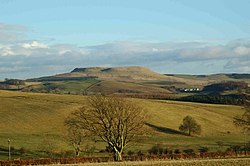
The location of the battle has intrigued historians for centuries. At the time, it must have been well known, too well known for any book to detail its location beyond the name "Brunanburh", but this knowledge has been lost, and no archaeological dig has found it either. Dozens of sites for the battle have been suggested in the past. Paul Hill has identified over thirty possibilities, some of which are still defended by local interest groups or minority critics.[5]
We have no clue beyond the name of the place in the records and assumptions of the antagonists' strategy. One difficulty is that the name Brunanburh has very common English place-name elements.
The location of the battle appears in various forms in the sources, among others:[6]
- Brunanburh (Anglo-Saxon Chronicle, the chronicle of John of Worcester, and in accounts derived from them),
- Brunandune (Aethelweard),
- Brunnanwerc or Bruneford or Weondune (Symeon of Durham and accounts derived from him),
- Brunefeld or Bruneford (William of Malmesbury and accounts derived from him),
- Duinbrunde (Scottish traditions),
- Brun (Welsh traditions),
- plaines of othlynn ("Annals of Clonmacnoise"),
- Vinheiðr (Egil's Saga, though this may refer to a battle on the Dvina).
The poem contains only four place-names, apart from the names of peoples:
Alistair Campbell concluded that:
The saga remains, accordingly, unsupported in practically all its details .. . If we abandon it, and abandon it we must, all hope of localising Brunanburh is lost. Unless new evidence can be produced, an honest nescio is greatly to be preferred to ambitious localisations built upon sand.
Many locations across Great Britain have been suggested, mainly between the River Dee and Dumfriesshire:
Cheshire
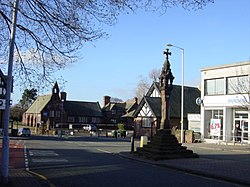
Bromborough, on the Wirral is earnestly believed locally to be the site. The name of Bromborough is etymologically the same as Brunanburh. No archaeology has been found to link it with the period though.
Bebington golf course has been suggested as the battle field, but with no evidence.
Devon
- Axminster: Suggested,[7] but discounted by most scholarship as too far south for the battle.
Dumfriesshire
Burnswark[8] is a Roman marching camp in Annandale. The name may reflect the Brunnanwerc of Symeon of Durham, and its position on the main marching route between Strathclyde and Northumbria makes it a strategically attractive as well.
Burnswark faces the Roman fort of Birrens, which reflects the account in Egil's Saga that the Norse and the English occupied two forts close to each other, the battle fought between them. However there is no archaeological evidence of reoccupation of the forts during the Dark Ages / Early Middle Ages.
County Durham
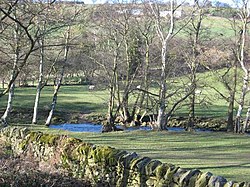
- Bosworth and Toller suggests a site "about five miles south-west of Durham, or on the plain between the river Tyne and the Browney" but admits the location unknown.
- Lanchester: the Roman fort of Longovicium stood where the Roman road known as Dere Street crosses the River Browney.[9]
400 years later a battle was fought by the River Browney; the Battle of Neville's Cross, 1346.
Lancashire: Burnley
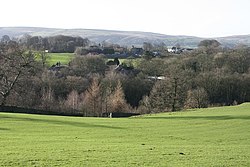
Burnley seems to be the leading contender. The River Brun runs from the hills above the town.
The position of the Cuerdale Hoard, though not directly connected with Brunanburh, suggests that the River Ribble was the beginning of a major overland route for trade and perhaps military ventures from Dublin to York. If Olaf's Dublin army took this path, up the Ribble to Cuerdale then overland in the valleys into the Pennines, they would have come into this very area. It is were a known path hemmed in by hills, it would be an ideal spot for an enemy to attack the column.
In 1856, Thomas T. Wilkinson, a master at Burnley Grammar School and antiquary, published a paper suggesting the moors above Burnley as the site of the battle, noting that the town stands on the River Brun.[10]
Local folklore told of a great battle at Saxifield during the Heptarchy, re-enforced by the occasional discovery of apparently human bones and iron arrowheads. The village of Worsthorne also had a tradition that the Danes constructed defences when a battle was fought on the moor that bares the same name, and that five kings were buried under tumuli[11] apparent in the area.
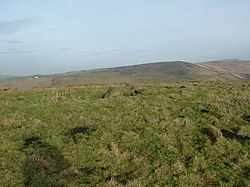
Wilkinson could not categorically identify a burh by the Brun, but he referenced the work of Thomas Dunham Whitaker listing what he felt was a large number of earthworks. Some such as Castercliff, Twist Castle and Ringstones Camp, he thought of Roman origin, but showed the historical significance of the area. For others like:
- an entrenchments on Broad Bank hill at Burwains farm[12] and
- Bonfire Hill[13]
- a possible camp on Shelfield Hill[14]
- around the site of the Victorian Walton Spire, and
- dykes at Saxifield, Thieveley,[15]
- Ree Lees,[16] and
- Broadclough[17] near Bacup
- Wilkinson felt indicated military activity during the period. He also showed that the Heasandford area of the town is named for a ford of the River Brun on an ancient trans-pennine route known locally as the long causeway, but in part as the Danes road. Wilkinson also equated the estate of Emmott with Eamot, the site of a treaty following the victory at York, the Swinden valley with Weondune, and Worsthorne with Bishop Wærstan who supposedly died fighting for Æthelstan. He also suggested that local place names like Winewall, Daneshouse, and Warcock hill could be significant and that the Cuerdale Hoard represented a Danish war chest lost as a result of the battle.
Wilkinson's work was subsequently referenced and expanded by a number of local authors.[18][19] New information was added including that around this time, the land between the rivers Ribble and Mersey had been re-conquered from Danish Northumbria and held by the crown until the Norman conquest. And although most of the sites mentioned have since been classified as much older, the story still interests some today.[20]
In addition, Brunanburh is also named 'Wendune' by Symeon of Durham, the Wen- element remaining in the village of Winwall, next to the conjectural battlefield (near Colne), and the name 'Vinheath' given by Egil’s Saga. Both ‘heath’ & ‘dune’ relate to the wide, raised land that the field lies on, as the word dun is 'consistently used for a low hill with a fairly extensive summit which provided a good settlement-site in open country' (Margaret Gelling). One final named for the battle, on 'The Plains of Othlynn' (in the Annals of Clonmacnoise) conjecturally connects to the Domesday Book’s Othlei, for Otley, whose lands stretched at least as far as Ilkley, a few short miles from the field. Others have suggested that Othlynn (the Annals exist only in a hurried early modern English translation) is an error or rough transcription for Lochlainn, meaning "Norway" or in context "Lands held by the Norse".
Lancashire - others
Cuerdale
The Cuerdale Hoard was found here, buried at some time in the early tenth century. It is a wealthy treasure hoard. It includes axeheads and spearheads, but the coins found in the hoard suggest that it was buried in between 902-910; there are no coins dated to later than 905, which is 32 years before the Battle of Brunanburh. The hoard may have been brought out of Dublin and buried for safekeeping after the Irish seized the town in 902. (Sihtric reconquered Dublin in 917.)
Others suggested
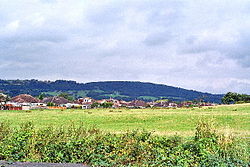
- Livesey (by Blackburn: The Livesey Historical Society (family history) says that the names Livesay and Livesey came from the common Anglo-Saxon personal name Leofsige, which means "beloved victory" or "he whose victory is beloved", and they suggest that that name refers to the Battle of Brunaburh.[21]
- Newton-le-Willows
Northumberland
- Broomridge, suggested by Jonathan Kenaz.[22]
- No particular site has attracted serious academic study, but the county is a generally probable location.
Yorkshire
- Tinsley Wood / Brinsworth was suggested by Michael Wood.[23]
- Near the Humber in Yorkshire or in Lincolnshire
Background
In 926, Sihtic (Siggtryggr) of Dublin, who had also conquered York, married Athelstan's sister. The next year, 927, he died and Athelstan annexed Northumbria (after a brief struggle with Guthfrith, Sihtric's cousin), thus becoming the first effective single king over all the English, from the English Channel to the Firth of Forth. In the same year, Athelstan and all the kings of Britain made a treaty æt Eamotum (probably Eamont Bridge) apparently recognising Athelstan's overlordship, and forbidding heathen practices throughout their realms. Athelstan assumed the title Rex Totius Britanniae.
In May 934, Athelstan, with Hywel Dda of Deheubarth, Idwal Foel of Gwynedd, Morgan ap Owain of Gwent and Tewdwr ap Griffri of Brycheiniog, invaded Scotland, the reason is not recorded, and restored the position settled at Eamont (later Constantine of the Scots was to witness a charter not as rex but as subregulus; "underking").
Athelstan's power appeared to be a threat to his northern neighbours and Olaf Guthfrithsson yearned for his uncle's kingdom[24] which was enough to assemble a bizarre alliance of former enemies; Olaf III Guthfrithson of Dublin, Constantine II of Scotland and Owen I of Strathclyde. Irish records state that Olaf first defeated a rival and namesake, Amlaíb [Olaf] Cenncairech at Limerick in August 937, then he crossed the sea with a large army to join the forces of Constantine and Owen, suggesting that the Battle of Brunanburh probably occurred in early October of that year.[25]
No detail of the campaign is stated in any reliable source (Michael Livingston, 2011, suggests two waves, from the north and from the Mersey, in order to justify his Bromborough theory). Snorri says the Norse entered the Humber, but there is no evidence. At some point, somewhere, the armies met spear to spear in bloody slaughter.
Battle
The mediæval records of the battle are too elusive to trace the course of the battle with any surety, but the sources consistently describe it as a massive and bloody engagement even within the context of warfare in the Middle Ages.[26][27][28]
The famous poem about the battle in the Anglo-Saxon Chronicle records the deaths of five kings and seven earls among Æthelstan's enemies, along with (or among them) Constantine's son:
. . . Five lay
On that battleplace, young kings,
By swords sent to death, of such seven also
Earls of Anlaf's, numberless of the army,
Of sailors and Scots. There was sent fleeing
The Northmen's chief, bidden by force,
To the ship's stem, little troop;
Crept the ship on the flood, the king went out
On the dark flood, his life saved.
Suchlike there also the old campaigner in flight came
Into his familiar north, Constantine,
Hoary warrior. To exult had he no cause
Of the great meeting; he was shorn of his kinsman,
Friend fell in the place of nations,
Slain at strife, and his son left behind
On the slaughterplace, ground to pieces by wounds,
Young at war. To boast had no cause
The blond-haired warrior of sword-slaughter,
Old deceiver, no Anlaf thus more;
With his army remnant thought to laugh
That they would better warwork
On battle place standard clashing,
Spear meeting, men's assembly,
Weapon exchanging, that they on the slaughter field
With Edward's children played. [29]
Æthelweard's Chronicle notes that the battle was still called "the great war" by people in his day.[30] The poem describes the aftermath in traditional terms, which Tennyson rendered as:
Many a carcase they left to be carrion,
Many a livid one, many a sallow-skin--
Left for the white-tail'd eagle to tear it, and
Left for the horny-nibb'd raven to rend it, and
Gave to the garbaging war-hawk to gorge it, and
That grey beast, the wolf of the weald.
The Annals of Ulster describes the battle similarly:
A huge war, lamentable and horrible, was cruelly waged between the Saxons and Norsemen. Many thousands of Norsemen beyond number died although King Anlaf escaped with a few men. While a great number of the Saxons also fell on the other side, Æthelstan, king of the Saxons, was enriched by the great victory.[31]
The largest list of those killed at the battle comes from the Annals of Clonmacnoise and names several kings and princes.[32]
Aftermath
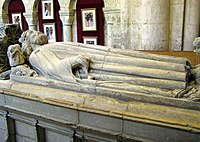
Athelstan's victory over the combined Norse-Scottish-Strathclyde force facing him confirmed England as a fully unified kingdom. The bloodshed weakened English arms as it did its opponents, and Olaf Guthfrithson managed to seize York again later in Athelstan's reign but as an underking within the English system. Thus while the Norse and even the Scots did subsequently invade, and briefly at Athelstan's death they took even the Danelaw in the Midlands, the Kings of the English were ready to expel them. Four Norse kings did exploit English weakness to set themselves up in York, but they held on only by swearing allegiance, and each was expelled in turn.
Owen of Strathclyde lay dead, and soon his kingdom would be absorbed by the Scots: the Anglo-Saxon Chronicle records that King Edmund, who had fought at Brunanburh, ravaged Cumbraland and granted it to King Malcolm.
Constantine fled and abdicated, becoming a Culdee monk at St Andrews, and was succeeded by Malcolm I, who did invade a weakened England, but was chastised and later received Strathclyde in return for his allegiance.
The Norse were chastened but not entirely suppressed; Olaf Guthfrithson returned and ruled at York for three years, and in turn Olaf Sihtricson seized his late father's seat, as Edmund's underking, until expelled. King Edred bloodlessly expelled the last Norse king from York in 954.
In Malmesbury in Wiltshire King Athelstan granted the townsfolk five hides (600 acres) of land[33] and gave them all freemen status. This status and the organisation formed then exists today, as the Warden and Freemen of Malmesbury, and Athelstan is remembered in their ceremonies.[34] When Athelstan died, his body was transported from Gloucester to Malmesbury for burial.
Popular culture
The Battle of Brunanburh came to popular attention again in the Victorian Age, when romanticism of the Middle Ages and of the Anglo-Saxons in particular was a strong force in popular culture. Alfred Lord Tennyson wrote a translation of the poem, reclaiming much of its vigour. Jorge Luis Borges wrote on it too.[35]
Outside links
- Text of the poem "Battle of Brunanburh", including Anglo-Saxon version, modern English translation, and Tennyson's version
- Short documentary produced by C Bebenezer about aural traditions and the possible Burnley location of the battle
References
- ↑ Alfred Smyth, Scandinavian York and Dublin (Dublin: Irish Academic Press, 1987), 2.62.
- ↑ Michael Livingston, 'The Roads to Brunanburh', in The Battle of Brunanburh: A Casebook, ed. Livingston (University of Exeter Press, 2011), p. 1.
- ↑ Annals of Ulster, trans. Scott Thompson Smith, in The Battle of Brunanburh: A Casebook, ed. Livingston (2011), p. 145.
- ↑ Livingston (2011), pp. 20–23.
- ↑ Paul Hill, The Age of Athelstan: Britain's Forgotten History (Stroud: Tempus, 2004), pp. 141–42.
- ↑ A summary of these spellings is provided in Paul Cavill, 'The Place-Name Debate', in Livingston (2011), pp. 329–30
- ↑ Lawrence Snell. The Suppression of the Religious Foundations of Devon and Cornwall (1966).
- ↑ "Battle of Brunanburh". UK Battlefields Trust. http://www.battlefieldstrust.com/resource-centre/viking/battleview.asp?BattleFieldId=59. Retrieved 7 June 2012.
- ↑ 'Lanchester - birthplace of a unified kingdom?', The Northern Echo 4 October 2013
- ↑ Wilkinson, Thomas T (1857), Transactions of the Historic Society of Lancashire and Cheshire, Volume 9
- ↑ National Monuments Record: No. 45325 – Monument No. 45325
- ↑ National Monuments Record: No. 46151 – Burwains camp
- ↑ National Monuments Record: No. 45311 – Monument No. 45311
- ↑ National Monuments Record: No. 45251 – Monument No. 45251
- ↑ National Monuments Record: No. 45212 – Monument No. 45212
- ↑ Lees Intrenchments&resourceID=2 National Monuments Record: No. 45332Red Lees Intrenchments
- ↑ National Monuments Record: No. 45222 – Monument No. 45222
- ↑ Partington, S W (1909), The Danes in Lancashire and Yorkshire, pp. 28–43, http://archive.org/stream/danesinlancashir00partrich, retrieved 2012-05-15
- ↑ Newbigging, Thomas (1893), History of the Forest of Rossendale, pp. 9–21, http://www.archive.org/details/historyofforesto00newb, retrieved 2012-05-15
- ↑ "Was epic Anglo-Saxon battle fought in Burnley?". Burnley Express. 9 August 2011. http://www.burnleyexpress.net/community/peek-into-the-past/was_epic_anglo_saxon_battle_fought_in_burnley_1_3661559. Retrieved 2012-05-15.
- ↑ "LivesayName". Lhsociety.org. http://www.lhsociety.org/LivesayName.html. Retrieved 2012-11-12.
- ↑ http://www.brunanburh.org.uk/location/broomridge Brunanburh.org.uk]
- ↑ Michael Wood, In Search of England (London: Viking, 1999) pp. 203–21.
- ↑ "h2g2 - The Battle of Brunanburh, 937 AD". Bbc.co.uk. http://www.bbc.co.uk/dna/h2g2/A3483029. Retrieved 2012-11-12.
- ↑ Livingston (2011), p. 14.
- ↑ Wendover. Flowers of History. p. 249
- ↑ Huntingdon. Historia Anglorum. Tr. Greenway. pp. 313-315
- ↑ Mac Airt, Seán and Gearóid Mac Niocaill (eds and trs.). The Annals of Ulster pp. 386-387
- ↑ 'The Battle of Brunanburh' (Version A, translated)
- ↑ Æthelweard, Chronicle, trans. Scott Thompson Smith, quoted in Livingston (2011), p. 49.
- ↑ Annals of Ulster, trans. Scott Thompson Smith, in The Battle of Brunanburh: A Casebook, ed. Livingston (2011), p. 145.
- ↑ Livingston (2011), pp. 20–23.
- ↑ Paul Hill, The Age of Athelstan, p. 33.
- ↑ Warden and Freemen of Malmesbury. Athelstan Museum. Retrieved 7 December 2012
- ↑ Parker, Joanne: 'Brunanburh and the Victorian Imagination'.
Sources
Primary sources
- Anglo-Saxon Chronicle, ed. D. Dumville and S. Keynes, The Anglo-Saxon Chronicle. A Collaborative Edition. 8 vols. Cambridge, 1983; tr. Michael J Swanton, The Anglo-Saxon Chronicles. 2nd ed. London, 2000.
- Annals of Ulster, ed. and tr. Seán Mac Airt and Gearóid Mac Niocaill, The Annals of Ulster (to AD 1131). Dublin, 1983.
- Annals of the Four Masters, ed. and tr. John O’Donovan. Annála Rioghachta Éireann. Annals of the Kingdom of Ireland by the Four Masters. 7 vols. Royal Irish Academy. Dublin, 1848–51.
Secondary sources
- Æthelweard, Chronicon, ed. and tr. Alistair Campbell, The Chronicle of Æthelweard. London, 1961.
- William of Malmesbury, Gesta regum Anglorum, ed. and tr. R.A.B. Mynors, R. M. Thomson and M. Winterbottom, William of Malmesbury. Gesta Regum Anglorum. The History of the English Kings. OMT. 2 vols: vol 1. Oxford, 1998.
- Henry of Huntingdon, Historia Anglorum, ed. and tr. D.E. Greenway, Henry Archdeacon of Huntingdon. Historia Anglorum. The History of the English People. OMT. Oxford, 1996.
- Egils saga, ed. Finnur Jónsson, Egils saga Skallagrímssonar. Halle, 1894; tr. Herman Pálsson and Paul Edwards, Egil's Saga. Harmondsworth, 1976.
- Roger of Wendover. Flowers of History. Volume 1 tr. J. A. Giles, Henry G. Bohn 1849.
Studies
- The Battle of Brunanburh (Old English poem), ed. Alistair Campbell, The Battle of Brunanburh. London: Heinemann, 1938.
- An Oxford History of England, Volume 2: Anglo Saxon England
- Charles Hardwick, Ancient Battle-fields in Lancashire (London: Simpkin, Marshall & Co., Stationers' Hall Court, 1882)
- Peter Marren, Battles of the Dark Ages (Barnsley: Pen and Sword, 2006)
- Michael Livingston, ed., The Battle of Brunanburh: A Casebook (University of Exeter Press, 2011)
Further reading
- Breeze, Andrew (1999). "The Battle of Brunanburh and Welsh tradition". Neophilologicus 83: 479–82. doi:10.1023/A:1004398614393.
- Campbell, Alistair (1970-03-17). "Skaldic Verse and Anglo-Saxon History". Dorothea Coke Memorial Lecture. Viking Society for Northern Research. http://vsnrweb-publications.org.uk/Skaldic%20verse%20and%20anglo-saxon%20history.pdf. Retrieved 2009-08-25.
- Cavill, Paul; Stephen Harding and Judith Jesch (2004). "Revisiting Dingesmere". Journal of the English Place Name Society 36: 25–38. http://www.nottingham.ac.uk/-sczsteve/JEPNS_paper.PDF.
- Foot, Sarah, "Where English becomes British: Rethinking Contexts for Brunanburh," in Barrow, Julia; Andrew Wareham (2008). Myth, Rulership, Church and Charters: Essays in Honour of Nicholas Brooks. Aldershot: Ashgate. pp. 127–44.
- Halloran, Kevin (2005). "The Brunanburh Campaign: A Reappraisal". Scottish Historical Review 84 (2): 133–48. doi:10.3366/shr.2005.84.2.133.
- Higham, Nicholas J., "The Context of Brunanburh" in Rumble, A.R.; A.D. Mills (1997). Names, Places, People. An Onomastic Miscellany in Memory of John McNeal Dodgson. Stamford: Paul Watkins. pp. 144–56.
- Livingston, Michael (2011). The Battle of Brunanburh: A Casebook. Exeter: University of Exeter Press. ISBN 978-0-85989-863-8.
- Niles, J.D. (1987). Skaldic Technique in Brunanburh. 59. Scandinavian Studies. pp. 356–66.
- Orton, P. (1994). On the Transmission and Phonology of The Battle of Brunanburh. 24. LSE. pp. 1–28.
- Wood, Michael (1980). "Brunanburh Revisited". Saga Book of the Viking Society for Northern Research 20 (3): 200–217.
- "Tinsley Wood," in Wood, Michael (1999). In Search of England. London. pp. 203–21.